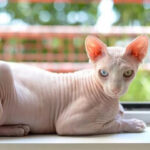Conjunctivitis, commonly referred to as “Eye Infection In Cats”, is a prevalent condition affecting felines of all ages. This inflammation of the conjunctiva, the delicate mucous membrane lining the inner eyelids and the surface of the eyeball, is arguably the most frequently encountered feline eye disorder. Many cat owners will observe at least a mild instance of this condition throughout their beloved pet’s life.
The conjunctiva plays a vital role in maintaining feline eye health. As explained by veterinary ophthalmologists, this membrane acts as a crucial lubrication system for the eyeball. It facilitates the distribution of tears across the eye surface with every blink, keeping it moist and comfortable. Furthermore, the conjunctiva is not merely a passive lining; it actively contributes to the eye’s defense mechanisms by housing antibodies that help combat potential infections. Despite these protective functions, cats are commonly carriers of various microorganisms, and their immune system’s inflammatory response to these, particularly bacteria and viruses, is the primary culprit behind most cases of feline conjunctivitis.
Recognizing the signs of an eye infection in cats is crucial for prompt care. These symptoms may manifest in one or both eyes and often involve the third eyelid, a protective membrane located in the inner corner of the cat’s eye. Common indicators include squinting, an increased frequency of blinking, and the presence of ocular discharge. This discharge can vary in appearance, ranging from clear and watery to thick and dark-colored, depending on the underlying cause of the conjunctivitis. Swelling and redness of the conjunctiva and the third eyelid are also typical signs of inflammation.
Alt text: Close-up of a cat’s face showcasing a visible eye infection with redness around the eye and noticeable discharge.
While environmental factors such as dust and chemical irritants can trigger conjunctivitis, leading to allergic reactions in the eyes, infections are by far the most common cause of eye infections in cats. The herpesvirus and calicivirus are frequent viral culprits, while bacteria like chlamydophila and mycoplasma are also significant contributors. Moreover, cats with weakened immune systems, often due to feline immunodeficiency virus (FIV) or feline leukemia virus (FeLV), are also more susceptible to developing conjunctivitis.
Although any cat can develop conjunctivitis, age is a significant predisposing factor. While older cats are not immune, eye infections are notably more prevalent in younger felines. This is particularly true in environments with multiple cats, such as catteries or shelters. In these settings, young cats are more likely to transmit infections among themselves through close contact and play. Similar to how colds spread among children, conjunctivitis can readily circulate within groups of young cats. While most cats will develop immunity after an initial episode, cats carrying the herpesvirus may experience recurring bouts of conjunctivitis throughout their lives, akin to human cold sores.
In many instances, feline conjunctivitis is a self-limiting condition that resolves without specific treatment. However, it’s essential for cat owners to seek veterinary attention if their cat exhibits signs of eye discomfort or discharge. Veterinary examination is crucial to rule out more serious eye conditions that may mimic conjunctivitis. Typically, veterinarians will prescribe antibiotic eye drops or ointments. These medications are usually administered three to four times daily for a duration of two to three weeks, effectively addressing bacterial infections. In cases where herpesvirus is suspected as the underlying cause, antiviral eye medications may be prescribed alongside antibiotics to manage the viral component and facilitate healing. While herpesvirus infections cannot be entirely cured, treatment aims to eliminate secondary bacterial infections and allow the eye to recover.
Alt text: A cat owner gently applying prescribed eye drops to their cat’s infected eye to treat conjunctivitis.
Prompt veterinary care and adherence to the prescribed treatment plan are key to managing eye infections in cats and ensuring their swift recovery and ongoing eye health.

